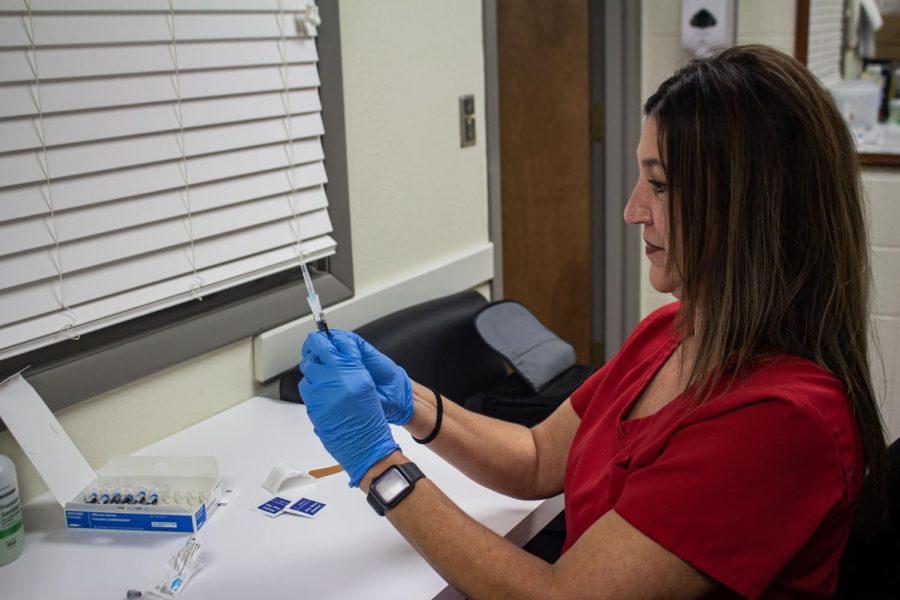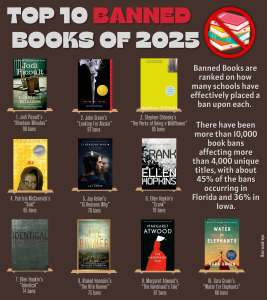Health Officials Give Vaccine Advice
Photo by Ellie Whitesell
Teresa Britton, nurse practitioner at the University Health Center filling a syringe. UCM’s health center offers flu shots as well as COVID-19 vaccines and boosters.
December 2, 2022
On Dec. 9, University of Central Missouri students will complete the Fall 2022 semester and have the chance to venture off campus for the Winter Break from Dec. 10 to Jan 8. The 28 days away bring opportunities for seeing family and friends to share gifts but also the flu. The Centers for Disease Control and Prevention has updated recommendations students can use to come back from Winter Break on Jan. 9 flu free.
With COVID-19 Vaccines:
According to the CDC, the COVID-19 vaccine recommendations are based on three things: the patient’s age, the vaccine the patient first received and the length of time since the last dose.
The CDC recommends people stay up to date with COVID-19 vaccines for their age group. The CDC said if you are at least 18 years old and have completed your primary series, but are not yet eligible for a booster, you are considered up to date.
People are also considered up to date if they received all COVID-19 vaccine doses recommended for them and then become ill with COVID-19. In that case, the CDC states you do not need to be immediately revaccinated or receive an additional booster.
The CDC states that if someone had COVID-19, they should consider delaying their next vaccine dose by three months from when symptoms started, or when they received their first positive test.
The CDC also states that those who are moderately or severely immunocompromised have different recommendations for COVID-19 vaccines. If you fall into this category, check to see if you need to get boosted using the CDC’s booster tool found on their website.
Getting boosted:
According to the CDC, updated bivalent boosters became available on Sept. 2 for people 12 years of age and older and on Oct. 12 for people aged 5-11.
Two COVID-19 vaccine manufacturers, Pfizer and Moderna, have developed updated (bivalent) COVID-19 boosters.
The CDC states these boosters are called “bivalent” because they have been shown to protect against both the original virus that causes COVID-19 and the Omicron variant BA.4 and BA.5.
According to the CDC’s website, “The virus that causes COVID-19 has changed over time. The different versions of the virus that have developed over time are called variants… CDC uses viral genomic surveillance to quickly identify and track COVID-19 variants, and acts upon these findings to best protect the public’s health.”
People ages five years and older are recommended by the CDC to receive a booster if it has been at least two months since their last COVID-19 vaccine dose.
As of Nov. 2, the CDC reported 84.8% of people eligible have gotten at least one dose of the COVID-19 vaccine. 72.6% of eligible people are fully vaccinated and only 8.4% of people eligible have gotten an updated booster.
2022 Flu Season:
The CDC states there are three flu vaccines that are preferentially recommended for people 65 years and older: Fluzone High-Dose Quadrivalent vaccine, Flublok Quadrivalent recombinant flu vaccine and Fluad Quadrivalent adjuvanted flu vaccine. These vaccines are recommended for the 2022-2023 flu season.
The timing for flu vaccination this year is similar to previous recommendations. The CDC states that those who only need one dose for the season should have gotten vaccinated in September or October. Earlier vaccination is not recommended for most people.
The CDC states that it’s ideal to get vaccinated by the end of October, but also stresses the importance of that fact that vaccination after October can still provide protection during the peak of flu season.
Coadministration:
The coadministration of vaccines is when a provider gives a patient one or more vaccines during a single visit. The CDC states this is common clinical practice because of the convenience of one appointment rather than multiple with the same provider. While there are some exceptions, the CDC states many vaccines can be given at the same visit.
A study from July 2022 by Anne M. Hause for the CDC concluded that it is safe to get both a flu vaccine and a COVID-19 vaccine at the same visit, the CDC states that studies similar to this were conducted throughout the pandemic.
Hause’s study also showed that people who got a flu vaccine and an mRNA COVID-19 booster vaccine at the same time were slightly more likely (8% to 11%) to have reactions including fatigue, headache and muscle ache than people who only got a COVID-19 mRNA booster vaccine, but these reactions were mostly mild and went away quickly.
The CDC concludes that findings of this study are consistent with safety data from clinical trials and neither found any safety concerns with giving both vaccines at the same time.








